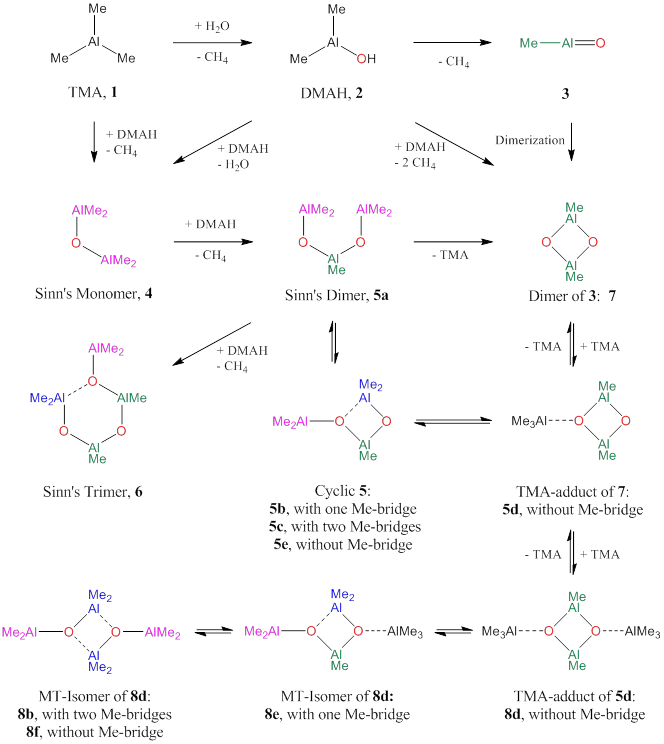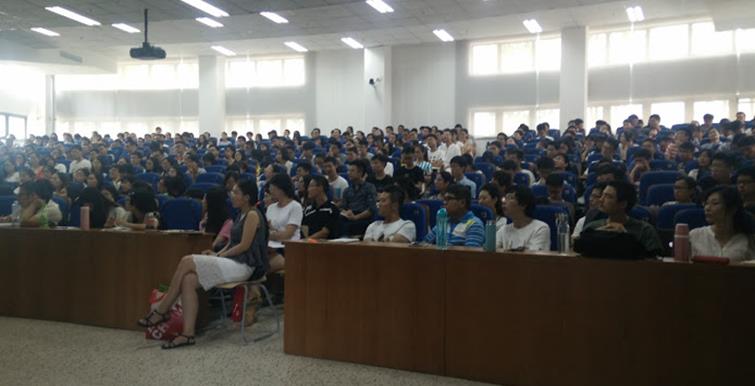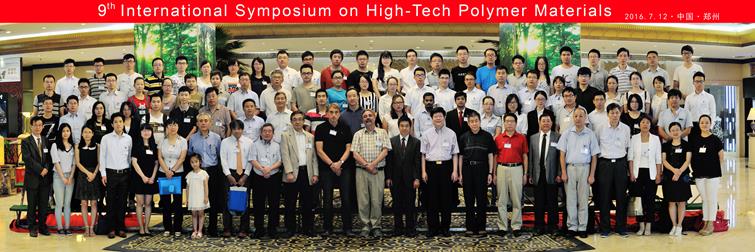Reports: ND440667-ND4: Mechanistic Studies of Transition-Metal Catalyzed, MAO-Assisted Olefin Polymerization
Rainer Ernst Glaser, Ph.D., MS, Dipl.-Chem., University of Missouri, Columbia
Even though methylaluminoxane (MAO) is a common co-catalyst in olefin polymerization, its structures and mechanistic functions remain unclear and a variety of species have been discussed. There is no doubt that hydrolysis of alkyl–Al bonds results in the formation of HO–Al bonds, the release of alkanes, and the formation of acyclic and cyclic systems with Al–O–Al bridges by further inter- and intramolecular alkane elimination. Initial ab initio studies of the hydrolysis of trimethylaluminum (J. Am. Chem. Soc. 2011, 133, 13323-13336) supported the possibility to form cyclodialuminoxane 7 from 2, and we have since performed a comprehensive study of the chemistry outlined in Figure 1.
Figure 1. Possible products formed by partial hydrolysis of trimethylaluminum 1: dimethyl-aluminum hydroxide 2, methylaluminum oxide 3, permethyldialuminoxane 4, permethyltrialuminoxane 5a, permethyltetraaluminoxane 6, and permethylcyclodialuminoxane 7.
One of the most important results was the finding that 5a can cyclize to methyl-bridged species 5b and 5c, and that methyl-transfer provides a path to 5d, the TMA adduct of 7, without going through 3 and without the need for the reactive dimerization of 2. The finding is significant because it shows that the structural space accessible to trialuminoxane 5 includes cyclic structure of types 5b and 5d, and one oxygen in both of these structures is very similar to the oxygens in 7. We have argued before that the oxygens in 7 are much better Lewis bases in intermolecular interactions as compared to acyclic aluminoxanes, and the intermolecular interaction of special interest concerns the ligating ability of the MAO species to transition metal catalysts in olefin polymerizations. With the malleability of the structure of 5, it is now possible to have the best of both worlds: there is no question that 5 is accessible without going through higher-energy species and cyclic 5 also should feature excellent ligating abilities of 7.
We have performed systematic and extensive studies of the ligating abilities of the acyclic dialuminoxane 4, of cyclodialuminoxane 7, and of the cyclic isomer of trialuminoxane 5 with iron complexes [LFeCl]+. The ligand L is a 2,6-diiminopyridine and we studied the DIP ligands with N-methyl or N-phenyl groups. Furthermore, we have studied the ligating abilities for all plausible spin states; open-shell singlet, triplet and quintet. Spin polarization is clearly important and the closed-shell singlet wave functions all exhibit UHF instabilities. Selected spin density distributions are shown in Figure 2. While there is some spin delocalization and/or spin polarization, most of the spin density in isomers of LFeCl(5b) resides on the transition metal center. Independent of the spin states of the complexes LFeCl(4), LFeCl(7) and LFeCl(5b), there always is a strong preference for the ligation of a cyclic aluminoxane compared to an acylic aluminoxane. The TOC graphic shows the spin densities of triplet and open-shell singlet complexes LFeCleq(5b).
Figure 2. Spin density distributions of the triplet, open-shell singlet (OSS) and quintet states of the [LFeCl]+, LFeCl2, and of isomers of LFeCl(5b).
International Collaboration in Research and Education. PRF funding enabled us to continue collaborations with Dr. W.-H. Sun of the Institute of Chemistry, Chinese Academy of Sciences, Beijing (ICCAS), Dr. C.-Y. Guo of the University of the Chinese Academy of Sciences, Beijing (UCAS), and Drs. B. Wu and J. Ma of the Department of Chemistry, Northwest University, Xi’an (NWU).
Figure 3. Audience of Scientific Writing on the new Yanqihu campus of UCAS.
The PI spent about five weeks in China in the summer of 2016. The PI taught a 20-hour course on Scientific Writing at the University of Chinese Academy of Science (UCAS) in Beijing in the week of June 20 to 300+ students. While the PI taught this course since 2010 on the Yuquanlu campus, in 2016 the UCAS summer school was taught on the beautiful new Yanqihu campus (Figure 3). Moreover, the PI stayed an extra ten days in 2016, until July 4, to video-record 10 hours of the course for MOOC delivery. The creation of the MOOC was an intense and exciting effort, which was made possible only because of the excellent support by and collaboration with my faculty liaison Dr. Guo, graduate student and teaching assistant Ms. K. Yang, and the competent and dedicated MOOC recording team. The MOOC program is ambitious in its scope, impressive for its high quality implementation, and unprecedented in its reach of CAS students across China. In August, the PI presented an invited lecture with the title Learning science ethics and science communication in the International Year of Pulses (with J. Schell, K. Yang, C. Hawkins, S. Herr, G. Houser, K. Maryan, and A. Song) to report on his curriculum developments for instruction on Scientific Writing and Scientific Peer Review in the Bodner-symposium at BCCE 2016 including highlights of the UCAS MOOC program.
The PI spent most of the remaining time in Xi’an, Shaanxi Province at Northwest University (NWU). During this time, the PI also visited the Department of Applied Chemistry, Northwestern Polytechnical University (NPU) in Xi’an where he presented two lectures on July 7; Structural Chemistry and Thermochemistry of MAO Formation. Studies of Cycloaluminoxane Ligands and of the Aggregation of Acyclic Aluminoxanes (with K. Yang) and 'Scientific Writing and Authoring' Instruction at the University of Missouri and the University of Chinese Academy of Sciences (with K. Yang, C.-Y. Guo, Y. Gu).
The PI traveled to Zhengzhou, Henan Province to participate in The 9th International Symposium On High-Tech Polymer Materials (HTPM-IX) - Synthesis, Characterization, and Applications, July 11-14, 2016 (Figure 4) and presented an invited lecture on Effects of Donor Solvation and Aggregation on Structures and Stabilities of Acyclic and Cyclic Aluminoxanes: Results of ab initio Studies Including Dispersion.
Figure 4. HTMP-IX Conference Participants on Zhengzhou, Henan Province.
Finally, the PI participated in the NSFC-British Council Workshop Energy and Environment at Northwest University, Xi’an, Shaanxi, July 15-18, 2016. The PI presented three invited lectures, two on Practical Tips for Young Global Scientists on Publishing Chemistry with focus on Pre-Writing and Writing and one lecture on Rubisco-Inspired Biomimetic Approaches To Reversible CO2 Capture From Air.















